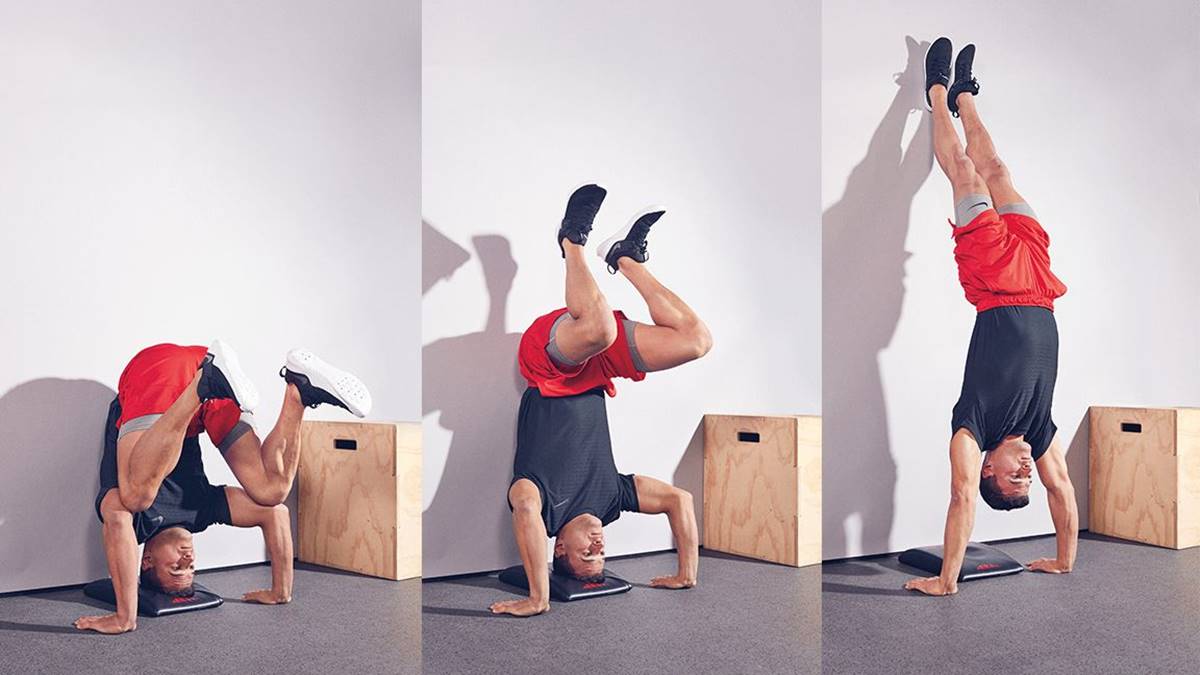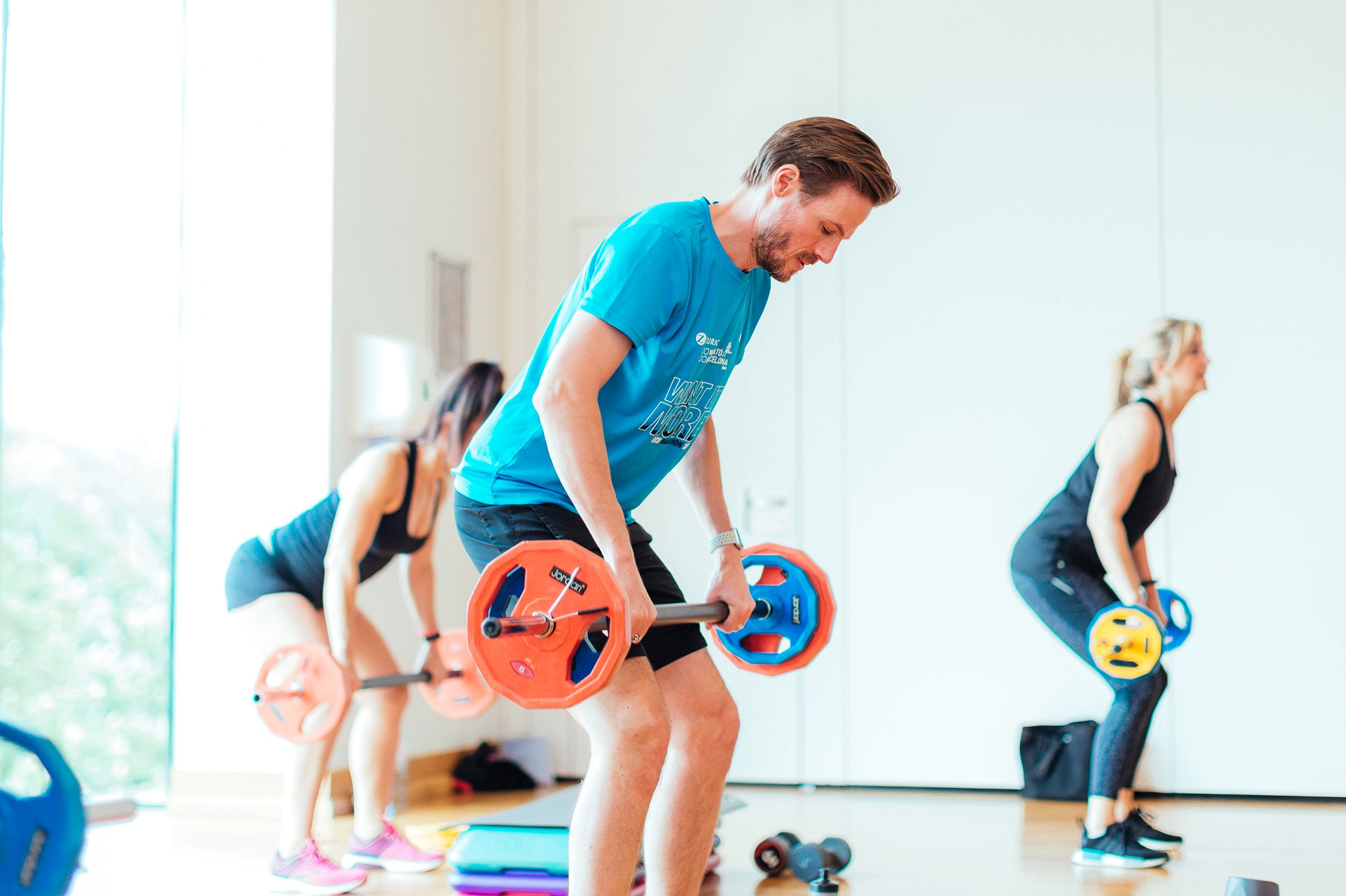

Featured
What Is An Exercise Progression?
Published: October 8, 2023
Discover what an exercise progression is and how it can help you achieve your fitness goals. Learn about featured exercises that can take your workout routine to the next level.
Introduction
Welcome to the world of fitness and exercise! If you’re new to the realm of working out or have been on a fitness journey for a while, you may have come across the term “exercise progression.” But what exactly does it mean?
Exercise progression refers to the process of gradually increasing the difficulty, intensity, or complexity of an exercise over time. It is an essential component of any well-rounded fitness program as it allows for continuous growth, improvement, and challenge. By progressively advancing your workouts, you can avoid plateaus, prevent injuries, and maximize the effectiveness of your training.
Exercise progression applies to various aspects of exercise, including resistance training, cardiovascular exercises, flexibility training, and even skills-based movements. Whether your goal is to build muscle, lose weight, improve athletic performance, or simply enhance your overall fitness level, exercise progression is a fundamental principle that can help you reach your objectives.
In this article, we will delve deeper into the concept of exercise progression, exploring its definition, benefits, principles, types, and how to design an effective progression plan. Additionally, we will identify common mistakes to avoid along the way.
So, if you’re ready to take your fitness journey to new heights and achieve remarkable results, let’s dive into the world of exercise progression!
Definition of Exercise Progression
Exercise progression involves systematically adjusting the variables of an exercise to make it more challenging as your body adapts and becomes stronger over time. It is the process of gradually increasing factors such as intensity, duration, resistance, volume, or difficulty level to stimulate ongoing improvements in your fitness and performance.
At its core, exercise progression aims to create a progressive overload on your muscles and cardiovascular system. By introducing incremental changes, you force your body to continually adapt and respond to the increased demands placed upon it. This adaptation process leads to enhanced strength, endurance, flexibility, and overall fitness.
Exercise progression can be applied in various ways, depending on the specific exercise and desired goals. For instance, in resistance training, progression can involve increasing the weights lifted, performing more repetitions or sets, or incorporating advanced variations of the exercise. When it comes to cardiovascular exercises, progression may involve extending the duration of your workouts, increasing the intensity by elevating heart rate, or incorporating interval training.
The key concept in exercise progression is finding the right balance between pushing yourself enough to stimulate adaptation without overwhelming your body. It’s important not to progress too quickly or aggressively, as this can lead to overtraining, injuries, or burnout. On the other hand, progressing too slowly may lead to reaching a plateau and hinder your progress.
Exercise progression is not a one-size-fits-all approach. It should be tailored to your individual fitness level, goals, and capabilities. A qualified fitness professional can help you design a specific progression plan that aligns with your needs and ensures safety and effectiveness.
By incorporating exercise progression into your fitness routine, you can constantly challenge yourself, break through plateaus, and continually improve your physical abilities. It provides a structured and systematic approach to training that helps you stay motivated, engaged, and excited about your workouts.
In the following sections, we will explore the numerous benefits of exercise progression and the principles that guide its implementation.
Benefits of Exercise Progression
Exercise progression offers a plethora of benefits for individuals of all fitness levels and goals. By gradually increasing the difficulty and intensity of your workouts, you can experience significant improvements in multiple aspects of your physical fitness and overall well-being. Let’s explore some of the key benefits of exercise progression:
- Continual Growth and Improvement: Exercise progression ensures that you are constantly challenging your body and pushing your limits. By consistently adapting and progressing, you can achieve ongoing growth in strength, cardiovascular fitness, flexibility, and overall performance.
- Prevents Plateaus: As you engage in regular exercise, your body becomes more efficient at performing the movements. However, this also means that it may require new challenges to continue making progress. Exercise progression prevents plateaus by introducing gradual changes that keep your body adapting and improving.
- Injury Prevention: Proper exercise progression involves gradually increasing the demands on your body, allowing your muscles, joints, and connective tissues to adapt and strengthen over time. This progressive approach helps reduce the risk of injuries by allowing your body to adjust and become more resilient to the demands of your workouts.
- Increased Motivation: Progressing in your workouts allows you to see tangible improvements in your fitness level. The sense of accomplishment and the satisfaction of reaching new milestones can greatly enhance your motivation, making it more likely that you’ll adhere to your exercise routine and continue pursuing your goals.
- Maximizes Results: Exercise progression optimizes the effectiveness of your workouts. By gradually increasing the demands placed on your body, you can elicit greater muscle activation, cardiovascular stress, and metabolic adaptations, leading to improved strength, endurance, muscle growth, and body composition.
- Mental Engagement: Long-term adherence to an exercise routine can be challenging if it becomes repetitive or monotonous. By incorporating exercise progression, you introduce variety, new challenges, and opportunities for skill development, keeping your workouts mentally stimulating and engaging.
- Goal Achievement: Exercise progression is essential for reaching your fitness goals. Whether you want to build muscle, lose weight, improve athletic performance, or enhance overall fitness, a well-designed progression plan ensures that you are consistently working toward and achieving your desired outcomes.
Overall, exercise progression is a vital component of any successful fitness program. It provides a structured and strategic approach to training, enabling you to continually challenge yourself, prevent plateaus, minimize the risk of injuries, and achieve remarkable improvements in your physical fitness and overall well-being.
Now that we understand the benefits of exercise progression, let’s explore the key principles that guide its effective implementation.
Principles of Exercise Progression
When it comes to implementing exercise progression effectively, there are several key principles to keep in mind. These principles serve as guidelines to ensure that you gradually and safely increase the difficulty of your workouts. Let’s explore these principles:
- Progressive Overload: This principle forms the foundation of exercise progression. It involves gradually increasing the demands placed on your body to stimulate adaptation. You can achieve progressive overload by manipulating factors such as intensity, volume, duration, resistance, or frequency of your workouts.
- Individualization: Exercise progression should be tailored to your specific goals, fitness level, and capabilities. What works for one person may not work for another. Consider factors such as your current fitness level, any limitations or injuries you may have, and your personal preferences when designing your progression plan.
- Safety: The safety of exercise progression cannot be emphasized enough. It is crucial to prioritize proper form, technique, and biomechanics throughout your workouts. Gradually increase intensity and difficulty levels while maintaining control and engaging appropriate muscles to prevent injuries.
- Consistency: Consistency is key when it comes to exercise progression. In order to see results and experience continual growth, it’s important to stick to your workouts and progression plan. Aim for a regular exercise routine and gradually advance your workouts over time.
- Periodization: Periodization is a strategy that involves dividing your training program into distinct phases or cycles. Each phase focuses on specific goals and emphasizes different aspects of fitness. By incorporating periodization, you can optimize progress, prevent overtraining, and maintain long-term motivation.
- Listen to Your Body: Pay attention to how your body feels and responds to the increasing difficulty of your workouts. If you experience excessive fatigue, pain, or other signs of overtraining, it’s important to dial back or modify your progression plan. Push yourself, but also give yourself adequate rest and recovery to avoid burnout or injuries.
- Variety: Incorporating variety in your workouts is crucial for effective exercise progression. This can include using different exercises, equipment, training modalities, or workout formats. By introducing variety, you challenge your body in new ways, keep your workouts interesting, and prevent staleness.
By adhering to these principles, you can ensure that your exercise progression is systematic, safe, and effective. It allows you to continually advance your workouts, overcome plateaus, and achieve your desired fitness goals in a way that suits your individual needs.
Next, let’s explore the different types of exercise progression that you can incorporate into your routine.
Types of Exercise Progression
Exercise progression can take on various forms to continuously challenge your body and promote growth. These different types of exercise progression allow you to target specific aspects of fitness and customize your workouts according to your goals. Let’s explore some common types of exercise progression:
- Weight Progression: This involves gradually increasing the amount of weight you lift during resistance training exercises. It can be done by adding more weight to the barbell, dumbbells, or machines. This type of progression helps build strength, muscle mass, and overall muscular endurance.
- Rep and Set Progression: Here, you gradually increase the number of repetitions (reps) or sets performed for a given exercise. This progression stimulates muscle endurance and can enhance muscular strength as well. For example, you can start by performing three sets of eight to ten reps and gradually increase to four sets or increase the reps to 12-15.
- Intensity Progression: Intensity progression refers to increasing the level of difficulty or effort in your workouts. This can be achieved by shortening rest periods, increasing the tempo of exercises, or incorporating advanced variations of the exercise. Increasing intensity helps improve cardiovascular fitness and can contribute to greater calorie burn.
- Duration Progression: Duration progression involves gradually increasing the time spent performing a particular exercise or workout. For example, you can start with a 20-minute jog and gradually increase to 30 or 40 minutes. This progression is commonly used in cardiovascular training and can help improve endurance and stamina.
- Range of Motion Progression: This type of progression focuses on increasing the range of motion in exercises. You gradually work towards achieving a fuller range of motion by safely improving flexibility and joint mobility. By steadily increasing the range, you can enhance muscle activation and overall functional movement patterns.
- Complexity Progression: Complexity progression involves adding more challenging movements or combining exercises to create more complex movement patterns. This progression is commonly used in skills-based exercises such as yoga, dance, or gymnastics. It helps improve coordination, balance, and body control.
- Training Frequency Progression: This type of progression involves gradually increasing the number of training sessions per week. It allows you to gradually expose your body to more exercise stimulus, promoting greater adaptation and progress. However, it’s important to listen to your body and ensure adequate rest and recovery between sessions.
These are just a few examples of the different types of exercise progression that you can incorporate into your workouts. You can choose one or a combination of these progressions depending on your goals, preferences, and the exercises you enjoy. Remember to always prioritize safety and proper form when advancing your workouts.
Next, let’s explore how to design an effective exercise progression plan.
How to Design an Exercise Progression
Designing an effective exercise progression plan involves careful consideration of your goals, current fitness level, and the principles of progression. By following a systematic approach, you can ensure consistent growth, prevent plateaus, and minimize the risk of injuries. Here are some steps to help you design an exercise progression plan:
- Assess Your Current Fitness Level: Begin by evaluating your current fitness level and identifying any areas of strength or areas that need improvement. Assess your strength, endurance, flexibility, and cardiovascular fitness. This will help you target specific areas for progression.
- Set Clear Goals: Determine your specific fitness goals. Do you want to build strength, increase muscle mass, improve cardiovascular endurance, or enhance overall fitness? Having clear goals will guide your exercise progression plan and ensure you’re working towards the outcomes you desire.
- Choose the Right Exercises: Select exercises that align with your goals and target the muscle groups or energy systems you want to develop. Consider exercises that can be easily progressed, such as compound movements that engage multiple muscle groups. Be sure to include a variety of exercises to prevent boredom and stimulate different areas of the body.
- Start with a Baseline: Begin your exercise progression plan with a baseline workout. This should be challenging but manageable, allowing you to perform the exercises with proper form and technique. Ensure you can complete the required number of repetitions and sets without compromising your form.
- Gradually Increase Intensity, Volume, or Difficulty: Once you have established a baseline, start progressively increasing the difficulty or intensity of your workouts. You can do this by adding weight, increasing the number of repetitions or sets, shortening rest periods, or incorporating more advanced variations of the exercises.
- Track Your Progress: Keep a record of your workouts, noting the details of each session such as weights used, number of reps, and any modifications made. This will help you track your progress over time and make informed decisions about when to progress to the next level.
- Reassess and Modify: Regularly reassess your fitness level and adjust your exercise progression plan accordingly. As you become stronger and more fit, you may need to increase the challenge to continue progressing. Periodically evaluate your goals and make sure they align with your current capabilities.
- Listen to Your Body: Pay attention to how your body feels during and after workouts. If you experience excessive fatigue or joint discomfort, it may be a sign that you need to modify your progression plan. Remember to prioritize rest and recovery to allow your body to adapt to the increased demands of your workouts.
By following these steps and principles, you can design an exercise progression plan that is tailored to your specific goals and abilities. Remember that progress takes time, and it’s important to be patient and consistent with your workouts. Gradually challenging yourself and making progressive changes will lead to significant improvements in your physical fitness and overall well-being.
Now that you understand the process of designing an exercise progression plan, let’s discuss some common mistakes to avoid in exercise progression.
Common Mistakes to Avoid in Exercise Progression
Exercise progression is a valuable tool for improving fitness and reaching your goals. However, it’s important to approach it with care and avoid common mistakes that can hinder your progress or lead to injuries. Here are some common mistakes to avoid in exercise progression:
- Progressing Too Quickly: One of the most common mistakes is progressing too quickly. While it’s important to challenge yourself, it’s equally important to give your body time to adapt to the demands of each progression level. Gradually increase the intensity, volume, or difficulty of your workouts to avoid overwhelming your body and risking injury.
- Ignoring Proper Form and Technique: It’s crucial to prioritize proper form and technique throughout your exercises. As you progress, it can be tempting to sacrifice form to lift heavier weights or complete more repetitions. However, this can lead to improper muscle activation, increased risk of injury, and diminished results. Always prioritize quality movement over quantity.
- Neglecting Warm-Up and Cool-Down: Skipping a proper warm-up and cool-down is a common mistake that can increase the risk of injuries and impede progress. Warm-up exercises prepare your body for the workout by increasing blood flow, loosening up muscles, and improving joint mobility. Cool-down exercises aid in recovery, stretch muscles, and promote flexibility. Make sure to allocate time for both.
- Overlooking Rest and Recovery: Rest and recovery are essential components of exercise progression. Pushing your body without adequate rest can lead to overtraining, fatigue, and increased risk of injuries. Listen to your body and allow for appropriate rest days to allow for muscle repair and adaptation.
- Sticking to a Comfort Zone: Challenge yourself by introducing variety and trying new exercises or training methods. Sticking to the same routine and exercises can lead to plateaus and decreased motivation. Embrace new challenges and step out of your comfort zone to continue progressing.
- Not Listening to Your Body: Your body provides valuable feedback during exercise. Ignoring signs of pain, discomfort, or exhaustion can lead to injury or setbacks. If something doesn’t feel right, modify the exercise or take a break. It’s important to push yourself, but also to prioritize your health and safety.
- Ignoring Personal Limitations: Each individual has unique capabilities and limitations. It’s important to identify and respect your own limitations. If you have pre-existing injuries or conditions, work with a fitness professional to modify exercises or choose alternatives that are safe and appropriate for your needs.
- Lack of Progression Plan: Without a clear progression plan, it’s easy to fall into a workout routine that lacks direction and structure. Plan your workouts in advance, set goals, and monitor your progress. A well-designed progression plan will ensure a systematic and effective approach to advancing your workouts.
Avoiding these common mistakes will help you achieve better results and minimize the risk of setbacks. Remember that exercise progression should be gradual, safe, and aligned with your individual capabilities and goals.
Now that we have explored the common mistakes to avoid, let’s wrap up with a summary of the importance of exercise progression and how it can transform your fitness journey.
Conclusion
Exercise progression is a crucial aspect of any successful fitness program. By gradually increasing the difficulty, intensity, or complexity of your workouts, you can continually challenge your body, avoid plateaus, and achieve remarkable improvements in strength, endurance, flexibility, and overall fitness.
Throughout this article, we explored the definition of exercise progression and its benefits. We discussed the principles that guide its implementation, including progressive overload, individualization, safety, consistency, periodization, listening to your body, and incorporating variety into your workouts.
We also explored various types of exercise progression, such as weight progression, rep and set progression, intensity progression, duration progression, range of motion progression, complexity progression, and training frequency progression. These different types allow you to target specific aspects of fitness and customize your workouts according to your goals and preferences.
Designing an effective exercise progression plan involves assessing your current fitness level, setting clear goals, choosing the right exercises, starting with a baseline, gradually increasing intensity or difficulty, tracking your progress, periodically reassessing, and listening to your body.
Lastly, we discussed common mistakes to avoid in exercise progression, including progressing too quickly, ignoring proper form, neglecting warm-up and cool-down, overlooking rest and recovery, sticking to a comfort zone, not listening to your body, ignoring personal limitations, and lack of a progression plan.
Remember, exercise progression is a journey. It takes time, consistency, and patience to see results. Be mindful of your body, listen to its cues, and make adjustments as needed. With a well-designed progression plan, you can achieve continuous growth, prevent plateaus, and reach your fitness goals.
So, embrace the power of exercise progression and take your fitness journey to new heights. Challenge yourself, stay motivated, and enjoy the incredible transformations that await you!









